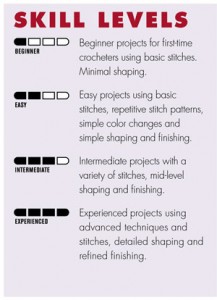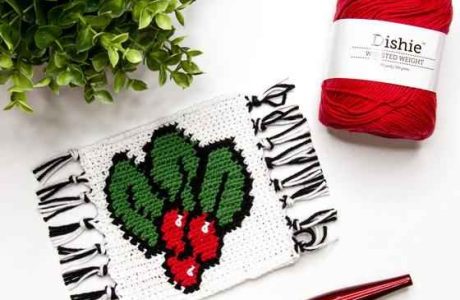Unless you’re a rank beginner at crochet, you probably have completed projects that range from Easy to Intermediate to Difficult to Challenging. These terms are, of course, somewhat questionable. What seems easy to one person may be extremely challenging to another crocheter. I know how to do a single crochet, but an entire project of single crochet would push a project into the category of Challenging. Why is it challenging? Not because of the stitch or even the choice of yarn. Rather, it would be simply, for me, a Nemesis project that I would never want to pick up – that would nag at me and would become a waste of time and yarn.
But, what about you? Do you look at those indications on patterns – the ones that tell you the pattern is Easy or Difficult? Do they inspire you or deter you? Do you find they are accurate? Useful?
I find that the level of difficulty usually refers to stitch patterns alone. But, I’d advise anyone who is not terribly experienced with crochet to consider Challenging any pattern that calls for Mohair yarn. That stuff is a bear to ‘frog’. Although I’ve been crocheting for many years now, I’ll always work a practice piece in simple acrylic yarn to be sure I have the stitch pattern down pat before I attempt it in Mohair. Can you tell I’ve had some bad experiences there?
The feedback I get from readers of this blog makes me feel that crocheters fall into two categories that I consider more important than their skill levels. Are they adventurous or not? If one is adventurous, even as a beginner, the difficulty labels are just noise. However, for the more cautious crocheter, the difficulty levels become confining, discouraging the crocheter from attempting something that might be beyond her level of expertise.
Several years ago, I taught a friend to crochet. I gave her a hook and some worsted weight yarn and taught her to chain and single crochet in about an hour one afternoon. That’s all I showed her. The next day, she showed up at work with a hobo sack type bag she had crocheted that evening!! She had crocheted to bottom circle then she figured out how to turn her crochet up to create the sides of the bag then she crocheted a shoulder strap for the bag! I was stunned! Clearly, she had not cooked dinner – but she swore she had gone to bed. She must have crocheted in her sleep! In less than 24 hours, she had gone from a non-crocheter to an amazing designer. She had no pattern for her bag, had never seen a pattern, didn’t know how to read a pattern. I guess we must just call her a natural!
Here’s a sample of Prudence Mapstone’s stunning freeform crochet from a recent showin
at the Getty Museum
On the other hand, I have a friend who is what I would call a master crocheter. She has excellent crochet skills, designs projects on her own, and produces beautiful, polished pieces. But – she must have a pattern. She cannot color outside the lines. Even in the projects she designs, she uses parts of other patterns that she combines to make the new items she has in mind. So, a doll and a baby afghan combine to make a nap time snuggly. She doesn’t understand or appreciate freeform crochet and has no interest in it.
So, who is the expert here? Who is the beginner and who the intermediate? Does it matter?
I think designers and publishers add those skill level designations in an attempt to help us. But, I think that, with few exceptions, the arbitrarily assigned skill levels are obstructive, discouraging beginners from stretching their fingers and skills, discouraging them from branching out to learn new techniques and to experiment to see how far they can go with their hooks and yarn.
What do you think? Are the skill levels on a pattern helpful or a hindrance? Do you pay attention to them? Do you trust them?
I’d love to hear your stories about the skill levels assigned to patterns.







I have been crocheting for about 35 years. I primarily make afghans and baby blankets, hats and scarves. I have made some without benefit of a pattern, but am more comfortable (and like the results better) using a pattern.
With regard to skill level, I don’t pay too much attention to it. If I see a pattern I like, I make it. However, there have been a few patterns that I will never do again!
I agree with Shawn…if I see something I like, then I’ll make it up. Since I rarely use the yarn weight that the pattern calls for, or even make it “to size”, the levels don’t faze me.
Pretty much the only time I pay attention to the level of a pattern is if I am selecting one for a friend that is a beginner so I don’t overwhelm them. The stitches themselves are like anything and just take a little practice and good directions/pictures. The only patterns I would label difficult would be the ones that are poorly written or have too many errors.
I L©©K at the picture an see different techniques. And I will start it, get ½ way thru, run into trouble with the distructions, THEN look at the skill level… I believe that the skill level is for deciphering the instructions on whether they are a typo or just me needing to sleep on it. There are patterns that are repetitive, such as all scs or dcs or filet patterns that are the same monotonous tedium. Bo-o-oring! I see something that gives a variety and I am happy! So far, I’ve done some simple projects for practice. It seems that the pretty patterns that are extremely challenging, entertaining for me, are the ones that are… NOT within my easy reach. Yes, it’s.the pattern instructions that are the skill levels.
Oh Yeahhhh! I have tried to “frog”, rip out, Mohair. Try Fun Fur! I was just thinking the other day on how much I miss Dazzlaire! (Spell?) It was so inexpensive too
I might glance at the rating, but it doesn’t usually influence my decision on whether or not to work the pattern. I’ve been crocheting for over 50 years, and while I still don’t consider myself an expert, I am certainly experienced. I like challenging patterns, but I rarely make a pattern more than once.
I’ve been crocheting about 40 years. Until lately I worked almost exclusively in thread. Time has slowly shifted me to more yarn projects because of arthritis and bad eyesight. But I still do a lot of work in #10 thread. I also prefer large projects. Give me a huge cone of thread and a one-piece pattern and I’m a happy camper 😉 (I hate ends!) So I’ve done a lot of tablecloths and several bedspreads. I much prefer symbol patterns. I’ve notice when Magic Crochet rates a pattern’s difficulty, it’s often marked as challenging merely because of the size of the project which I understand in one way but find annoying because it is rating my patience, not my skills.
I glance at the levels, but usually just read the pattern – if I like it I attempt it. Some come out great, some not so, but it is how the instructions are written. A lot of times I use the pattern as a guide and tweak here or there to fit my purposes – or I like to combine ideas, but I almost always start with a pattern as a guide regardless of the rating. If the instructions seem a little tough to follow – that is when I move on.
Excellent questions you pose here, JD! When I design my patterns for publication, I use something I call the “Schnauzer Difficulty Rating.” Rather than numbered bars like you’ve shown here, it uses outlined dog pictures with the appropriate number blacked in. Beginner = 1 schnauzer, for example. Makes more sense when you see it! Anyway, I struggle over rating my patterns too. Typically I will rate based on stitch most of the time. But you can have a 3D pattern that is complex to assemble even if it’s just single crochet! So my answer to that is to put a comment line on why I’ve rated it that level. Maybe I have an intermediate level pattern with 3-1/2 schnauzers, and I’ll say, “Requires double treble crochet” or whatever. I think the rating itself is not nearly as important as knowing why the designer believes the pattern is appropriate for whatever skill level.
I just bought a book with a pattern for a shruggie it called for 76 stitches in a pattern ,which I did then still in row one it said to do 58 dc ,didn’t t say to turn or any thing and with no more chain I had to quit. I am not that good of a crochet person and am 73 so I like easy patterns
Marlene,
Can you give us the name of the book or the pattern. I or another reader might be able to interpret the pattern for you. Lots of them have errors but a lot of problems are also ‘user error’.
jd